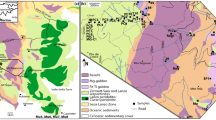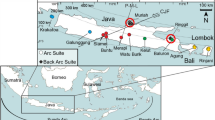Abstract.
Major and selected trace element abundances of MORB dredged from the moderately slow spreading southern MAR (40–55°S), in the vicinity of the Shona and Discovery mantle plumes, are used to constrain their melting conditions. All samples plot to high Fe8 relative to the Na8–Fe8 global trend, the high Fe8 of N-MORB in particular being anomalous. Shona-influenced MORB plot at lower Na8 and towards higher Fe8 values along the global trend than associated N-MORB, consistent with deeper initiation of melting. Discovery-influenced MORB extend to higher Na8 and lower Fe8 compositions than associated N-MORB. Anomalous Na8 and Fe8, and Si8, Ca8 and Al8, of most Discovery-influenced MORB are interpreted to reflect increased modal clinopyroxene in their source regions. Calculated Fmean range from 15–17% for N-MORB, 16–19% for Shona-influenced MORB, and ~11–18.5% for selected, least-anomalous Discovery(+LOMU)-influenced MORB. Calculated Pinitial are fairly constant for N-MORB (~18±2 kbar), slightly greater for Shona-influenced MORB (~20±3 kbar), whereas for least anomalous Discovery(+LOMU)-influenced MORB calculated Pinitial group around ~16±2 and ~22 kbar. Calculated crustal thicknesses range mostly between 6–9 km, but for Shona- and a single Discovery(+LOMU)-influenced MORB location the range is 8–12 km. Anomalous compositions of some Discovery-influenced MORB are interpreted to reflect variable melting of pyroxenite veins, initially formed as small-degree (2–3%) melts of garnet lherzolite within the upwelling off-axis Discovery mantle plume, and subsequently entrained in the ambient spinel lherzolite beneath the ridge axis. Because of lower solidus temperatures relative to ambient spinel lherzolite, initial melting preferentially consumed the low abundance (2.5–3.5%) pyroxenite veins. Variable mixing between vein- and host mantle-derived melts led to the range of Discovery(+LOMU)-influenced MORB compositions. In the vicinity of transform off-sets, melting is restricted to a narrow pressure interval, and melts are ineffectively homogenized and focused towards segment centres. Beneath slower spreading ridges, such as the southern MAR, reduced heat flux further retards melt homogenization and focusing, resulting in high proportions (≤40%) of pyroxenite-derived melt in final magmas erupted up to ~30–40 km from ridge segment ends, i.e. retaining a strong pyroxenitic source signature. Electronic supplementary material to this paper can be obtained by using the Springer LINK server located at http://dx.doi.org/10.1007/s00410-002-0376-3.
Similar content being viewed by others
Author information
Authors and Affiliations
Additional information
Electronic Publication
Rights and permissions
About this article
Cite this article
le Roux, .P., le Roex, .A. & Schilling, .JG. MORB melting processes beneath the southern Mid-Atlantic Ridge (40–55°S): a role for mantle plume-derived pyroxenite. Contrib Mineral Petrol 144, 206–229 (2002). https://doi.org/10.1007/s00410-002-0376-3
Received:
Accepted:
Issue Date:
DOI: https://doi.org/10.1007/s00410-002-0376-3




